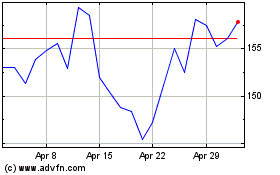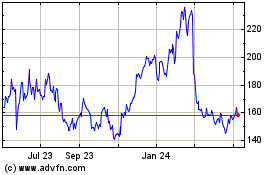Snowflake's Cloud is Particularly Dense -- Heard on the Street
December 03 2020 - 1:23PM
Dow Jones News
By Dan Gallagher
The beauty of a snowflake is that each one is unique. For
Snowflake the company, that also will prove to be a challenge.
The provider of cloud-based data warehousing services went
public in September in what has been the hottest stock debut so far
this year. Snowflake's share price more than doubled on its first
trading day and the stock gained another 15% ahead of its first
quarterly report as a public company on Wednesday afternoon.
That report turned out to be mixed. Revenue for the fiscal third
quarter surged 119% year-over-year to $159.6 million, beating Wall
Street's estimates. But the company's projection fell short, with
revenue expected to grow 88% year-over-year at the midpoint of its
range for the fourth quarter ending in January. Analysts had been
projecting growth of 102% for the period.
If the new projection holds, it will be the first quarter
Snowflake's revenue hasn't doubled on a year over year basis, at
least according to the limited financial history presented in its
initial-public-offering papers.
Surprisingly, a miss right out of the gate didn't melt the
stock. Snowflake's share price jumped 15% Thursday. Investors
remain enthralled with the long-term potential for the company'
services, which help businesses rapidly analyze information faster
than traditional database tools can. Demand boomed in the most
recent quarter, signified by remaining performance obligations --
contracted revenue not yet recognized -- exploding by 240%
year-over-year to about $928 million.
But Snowflake doesn't operate like a normal cloud software
company. Revenue isn't recognized until its service is actually
used -- a big difference from software-as-a-service, or SaaS,
business models that recognize contracted revenue on a ratable
basis over the contracted period. That makes Snowflake's actual
revenue much more difficult to forecast. The company noted on its
call Wednesday afternoon that new customers often take several
months before they are fully utilizing the service, even if they
have purchased a lot of service credits up front.
Thus, while most cloud software companies can predict revenue
with near-certainty a few quarters out, Snowflake's quarterly
results will be unique -- and much more volatile. That could be a
problem given the already nosebleed valuation that the stock
commands. The shares now trade at just under 100 times forward
sales. Besides Snowflake, the most richly-valued cloud stocks
currently garner multiples in the low-40 range. Post-IPO lockups
that begin expiring over the next three months add further
uncertainty.
Even perfect snowflakes tend to melt in the heat.
Write to Dan Gallagher at dan.gallagher@wsj.com
(END) Dow Jones Newswires
December 03, 2020 13:08 ET (18:08 GMT)
Copyright (c) 2020 Dow Jones & Company, Inc.
Snowflake (NYSE:SNOW)
Historical Stock Chart
From Mar 2024 to Apr 2024

Snowflake (NYSE:SNOW)
Historical Stock Chart
From Apr 2023 to Apr 2024
